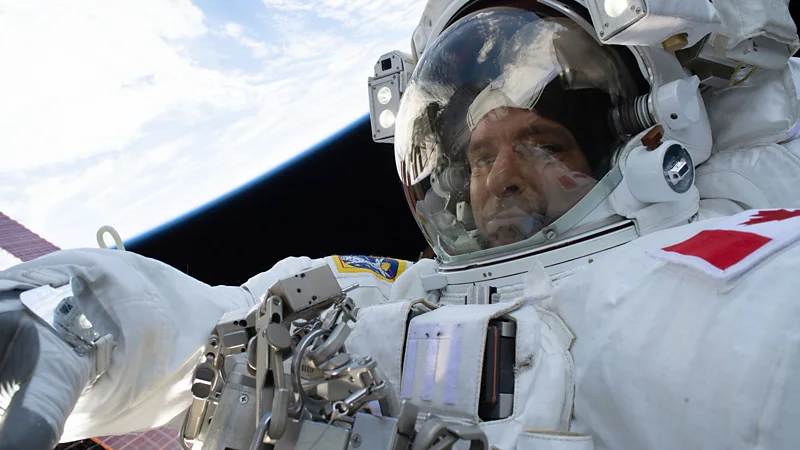From cat urine to gunpowder: Exploring the peculiar smells of outer space
Scientists are analysing the smells of space – from Earth's nearest neighbours to planets hundreds of light years away – to learn about the make-up of the Universe.

Jupiter, says Marina Barcenilla, is "a bit like a stink bomb".
The largest planet in the solar system, Jupiter has several layers of cloud, she explains, and each layer has a different chemical composition. The gas giant might tempt you in with the sweet aroma of its "poisonous marzipan clouds", she says. Then the smell "would only get worse as you go deeper".
"You would probably wish you were dead before you got to the point where you were crushed by the pressure," she says.
"The top layer of cloud, we believe, is made of ammonia ice," says Barcenilla, likening the stench to that of cat urine." Then, as you get further down, you encounter ammonium sulphide. That's when you have ammonia and sulphur together – a combination made in hell." Sulphurous compounds are famously responsible for stinking of rotting eggs.
If you were able to explore deeper still, she continues, you would encounter Jupiter's characteristic stripes and swirls. "Jupiter has these thick bands that are coloured. We think that some of these colours might be created by plumes of ammonia and phosphorus." There are also potentially some organic molecules called tholins, complex organic molecules related to gasoline. So, Jupiter, she says, may also have a note of petroleum "oiliness" with a blast of garlic.
Barcenilla is a space scientist, fragrance designer and astrobiology PhD student at the University of Westminster, London. In her early years studying the cosmos, she found herself constantly wondering, "what would that smell like?". Then she realised, "I have that molecule in my lab. I could actually go and create it".
So, alongside her academic work – searching for signs of life on Mars – Barcenilla has been busy designing scents recreating the odour of outer space for London's Natural History Museum's latest exhibition, Space: Could life exist beyond Earth?
From the stench of rotten eggs to the sweet scent of almonds, space is a surprisingly smelly place, she says. Comets, planets, moons and gas clouds would each have their own unique odour if we were able to sniff them with our noses. But what can these aromas reveal about the mysteries of the Universe?
Before we zip off to explore the olfactory delights of the cosmos, it is perhaps worth dwelling for a moment on what odours are in the first place.
Smell, though often under-appreciated, is arguably the most ancient of the senses. Take a tiny single-celled organism, a bacterium, bobbing through the Archaeozoic seas around 3.5 billion years ago. On sensing the presence of a chemical, perhaps a tasty nutrient or some danger to steer clear of, the bacterium's flagellum – its tail-like appendage – would act as a propeller, allowing this tiny creature to redirect its movements. To our earliest ancestors, this "most rudimentary sense of smell" was the difference between life and death.
And our own sense of smell is simply a more sophisticated version of this ability to detect chemicals in the environment around us. Our noses contain dense nerve clusters composed of millions of specialised neurons that are studded with molecules known as chemoreceptors. When they latch onto a chemical, they send a signal into our brains that is then interpreted as a distinct smell.
This sense of smell means we have the ability to the detect chemicals around us. For humans, smell not only helps us to identify foods or warns us of environmental hazards, it also triggers memories and plays a crucial role in social communication. After millions of years of evolution, the ability to smell is intrinsically linked to our emotional wellbeing.
During the long, isolated months in orbit, it can also be an important link to home for astronauts. But a space station can also be a strange place when it comes to odours too.
"Alexei Leonov [the first person to complete a space walk] was in charge of all the foreign astronauts," says Helen Sharman, the UK's first astronaut. It was 1991 and Sharman was preparing to spend eight days on Mir, the Soviet space station. Just before the launch, Leonov "handed me this little sprig of wormwood to take up". During her stay on the Mir, Sharman would occasionally crush the wormwood leaves in order to release its sage-like scent – because, she says, "it's nice to have a bit of a whiff of something".
On the Mir space station, Sharman explains, there was very little smell. In microgravity, hot air doesn't rise so "smells from hot food don't come up off of your plate". The only way to experience smell would be to "shove your nose into the packet", she says.
But there was one distinctive smell on the space station that many astronauts have reported following a spacewalk. "It reminded me of when I was a kid and I'd go past a car workshop," says Sharman. "I could smell some welding going on – that metal smell in the air."
During the mission, Sharman was conducting experiments on potential materials to use for spacecraft construction. "I had a load of thin films, mostly ceramics, that I had to put in a frame and then expose to the environment just around the space station."
When she brought her samples back in from the airlock, there was a rush of smell, the metallic aroma of space. "That was my favourite experiment – because it smelled." Other astronauts have described a smell akin to charred meat, gunpowder, or burnt electrical wiring.
But what causes this smell remains a mystery. One possible explanation, says Sharman, is that it is caused by oxidisation. "The atmosphere, the environment, just around the space station, is pretty much a vacuum, but not completely at that height," she says. "What we have in the residual atmosphere, is atomic oxygen."
Atomic oxygen – or single atoms of oxygen – can cling to an astronaut's spacesuit or tools. On re-entering the space station, the single oxygen atoms combine with O2, present in the cabin, making ozone (O3). "As soon as it reacts, you get that ozone smell," says Sharman. And we humans down here on Earth can experience the tang of ozone too. Have you ever noticed the metallic smell of static electricity just after a thunderstorm? That's ozone.
Another possibility is that Sharman was inhaling the atoms of a dying star. When a star dies, it releases a huge amount of energy. During this process the star produces polycyclic aromatic hydrocarbons (PAHs) – "chicken wire-shaped molecules" says Sharman – which float around the Universe and contribute to the creation of new comets, planets and stars.
On Earth, PAHs are present in fossil fuels, like coal, crude oil and petrol, and often form during incomplete combustion of organic materials. "If you burn your food," says Barcenilla, "that is the kind of molecule you're creating. When stars die, the combustion of this creates the same kind of molecules. Then they float around in space forever." Many of these compounds have a solvent-like or moth-ball odour, while others are more reminiscent of burning plastic or bitumen.
Data from space comes in all forms. The first science from space was delivered in 1958, by Nasa's Explorer 1, as sound. Fast forward to 2022, and Nasa's James Webb Space Telescope (JWST) caught the first ever whiff of carbon dioxide (CO2) in the atmosphere of an exoplanet – a planet outside of our own solar system – the gas giant WASP-39 b.
JWST didn't actually smell the CO2 in the sense of breathing it in, but detected its presence by tracking how the planet's atmosphere altered starlight when it passed in front of its sun. By analysing subtle changes in light, JWST can identify the various chemicals of alien worlds.
And "space is massive", says Barcenilla. It is full of worlds with smells that are many and varied. Chemical analysis of the atmosphere on Titan, Saturn's largest moon, suggests it smells of sweet almonds, petrol and rotting fish. Meanwhile, the "pong" of rotten eggs might put you off visiting planet HD 189733 b, a scorching hot gas giant about 64 light years from Earth.
Interstellar dust clouds, spinning through the spiral arms of the Milky Way, combine the smells of "crazy ice cream and knee-buckling ammonia", researchers believe. Meanwhile, in Sagittarius B2, a giant molecular cloud of gas and dust close to centre of our galaxy, you might smell "some of the prebiotic molecules that are necessary for life", says Barcenilla. "There we have things like ethanol, methanol, acetone, hydrogen sulphide and ethylene glycol – which you can use as antifreeze."
Ethyl formate is commonly credited with giving the centre of the Milky Way the scent of raspberries, but, says Barcenilla, this is not completely accurate. "It's just one molecule among many and if you smell it in isolation, it doesn't smell like raspberries." Ethyl formate, she explains, is found inside various fruits. "It's partly responsible for the flavour – not the smell – of raspberries, but it's also partly responsible for the flavour of other fruits as well. [It is also] associated with nail varnish or maybe nail polish remover, and a kind of alcoholic, almost rum-type of smell."
And sniffing for cosmic chemicals can not only give us vital details about the make-up of the Universe, but it can also give us clues about where to look for life, says Barcenilla.
"If you were able to somehow ride a boat on [planet] K2-18b – if there was an ocean there, and you were able to take your space suit off – then it might smell like rotten cabbage," says Subhajit Sarkar, an astrophysicist at Cardiff University.
In 2023, Sarkar was part of a team that, with the help of JWST, caught what could be the scent of life on K2-18b, an exoplanet roughly 120 light years from Earth. The telescope detected "the merest hint", says Sarkar, of dimethyl sulphide (DMS), sometimes credited as one of the main components that produce the "smell of the sea".
"K2-18b is interesting for a number of reasons," says Sarkar. "It's part of a larger group of exoplanets called sub-Neptunes." Bigger than Earth but smaller than Neptune, sub-Neptunes are the most common type of planet in the galaxy and, despite their prevalence, much about them remains a mystery.
"There are big questions about sub-Neptunes," says Sarkar. "Why don't they exist in our Solar System? And what are they made of?" One way we can try and understand them better, according to Sarkar, is to look at their atmospheres. "K2-18b was known to be a good target for that."
K2-18b is, in theory, a "hycean" world, a habitable ocean-covered exoplanet. In 2025, Sarkar and his colleagues reanalysed K2-18b's atmosphere – and got an even stronger whiff of atmospheric chemicals that, as far as we know, are only produced by life – specifically phytoplankton and other marine organisms.
According to the researchers, K2-18b's atmosphere may contain DMS and/or dimethyl disulphide (DMDS). "At this time, we're not aware of non-biological processes that can produce these [chemicals] in large quantities. Certainly, on Earth it is very, very clear that the DMS and DMDS are produced by biology. They're very specific biosignatures from that point of view," says Sarkar.
And with concentrations that are 10,000 times those found in Earth's atmosphere, the findings suggests K2-18b could have an ocean "teeming with life", says Sarkar. But, he cautions, it is possible the chemicals come from abiotic sources, and that more investigation is needed. However, he adds, if K2-18b is indeed a habitable ocean world "then it fits into that picture, because then you have marine life potentially producing this molecule that, on Earth, is associated with marine life".
So a journey into space may not be necessary to experience what it actually smells like. Many of the odours of space are familiar to us and found right here on Earth – and a few people have attempted to recreate the scent of space, including Barcenilla.
When I poke my own nose into her Mars scent pod at the Natural History Museum exhibition – I smell rust, dust and a hint of damp. The smell conjures a memory: the back corner of a garage, one piled with old cardboard boxes full of once-loved books, and bits of wood from generations-old furniture. A homely, childhood smell.
But perhaps the greatest olfactory treasure of all is not found far out to space, but here on Earth. There is nothing like the scent of our own planet, says Sharman. She describes her return home in 1991, still vivid in her mind. "It was the end of May so, even in Central Asia, the ground wasn't bone dry the day we arrived back on Earth."
As it landed, the spacecraft bounced "quite a bit", crushing the plants on the ground underneath. "We landed on this wormwood scrub vegetation in Kazakhstan," recalls Sharman. "The rush of fresh air when we opened the hatch just fantastic. It smelled gorgeous, absolutely delicious."
-BBC







